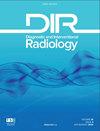Noncavernous arteriovenous shunts mimicking carotid cavernous fistulae.
IF 2.1
4区 医学
Q2 Medicine
引用次数: 11
Abstract
PURPOSE The classic symptoms and signs of carotid cavernous sinus fistula or cavernous sinus dural arteriovenous fistula (AVF) consist of eye redness, exophthalmos, and gaze abnormality. The angiography findings typically consist of arteriovenous shunt at cavernous sinus with ophthalmic venous drainage with or without cortical venous reflux. In rare circumstances, the shunts are localized outside the cavernous sinus, but mimic symptoms and radiography of the cavernous shunt. We would like to present the other locations of the arteriovenous shunt, which mimic the clinical presentation of carotid cavernous fistulae, and analyze venous drainages. METHODS We retrospectively examined the records of 350 patients who were given provisional diagnoses of carotid cavernous sinus fistulae or cavernous sinus dural AVF in the division of Interventional Neuroradiology, Ramathibodi Hospital, Bangkok between 2008 and 2014. Any patient with cavernous arteriovenous shunt was excluded. RESULTS Of those 350 patients, 10 patients (2.85%) were identified as having noncavernous sinus AVF. The angiographic diagnoses consisted of three anterior condylar (hypoglossal) dural AVF, two traumatic middle meningeal AVF, one lesser sphenoid wing dural AVF, one vertebro-vertebral fistula (VVF), one intraorbital AVF, one direct dural artery to cortical vein dural AVF, and one transverse-sigmoid dural AVF. Six cases (60%) were found to have venous efferent obstruction. CONCLUSION Arteriovenous shunts mimicking the cavernous AVF are rare, with a prevalence of only 2.85% in this series. The clinical presentation mainly depends on venous outflow. The venous outlet of the arteriovenous shunts is influenced by venous afferent-efferent patterns according to the venous anatomy of the central nervous system and the skull base, as well as by architectural disturbance, specifically, obstruction of the venous outflow.模拟颈动脉海绵状瘘的非海绵状动静脉分流术。
目的颈动脉海绵窦瘘或海绵窦硬膜动静脉瘘(AVF)的典型症状和体征为眼红肿、眼球突出、凝视异常。血管造影典型表现为海绵窦动静脉分流伴眼静脉引流伴或不伴皮质静脉回流。在极少数情况下,分流位于海绵窦外,但类似海绵窦分流的症状和影像学表现。我们想介绍其他位置的动静脉分流,模仿颈动脉海绵状瘘的临床表现,并分析静脉引流。方法回顾性分析2008 - 2014年在曼谷Ramathibodi医院介入神经放射科临时诊断为颈动脉海绵窦瘘或海绵窦硬膜AVF的350例患者的记录。排除海绵状动静脉分流术患者。结果在350例患者中,10例(2.85%)确诊为非海绵窦性房颤。血管造影诊断包括3例前髁(舌下)硬脑膜AVF, 2例外伤性中脑膜AVF, 1例小蝶翼硬脑膜AVF, 1例椎-椎瘘,1例眶内AVF, 1例硬脑膜动脉-硬脑膜皮质静脉直接AVF, 1例横乙状状硬脑膜AVF。6例(60%)出现静脉传出梗阻。结论类似海绵状AVF的动静脉分流是罕见的,发生率仅为2.85%。临床表现以静脉流出为主。根据中枢神经系统和颅底的静脉解剖,动静脉分流的静脉出口受到静脉传入-传出模式的影响,也受到建筑障碍的影响,特别是静脉流出受阻。
本文章由计算机程序翻译,如有差异,请以英文原文为准。
求助全文
约1分钟内获得全文
求助全文
来源期刊
CiteScore
3.50
自引率
4.80%
发文量
69
审稿时长
6-12 weeks
期刊介绍:
Diagnostic and Interventional Radiology (Diagn Interv Radiol) is the open access, online-only official publication of Turkish Society of Radiology. It is published bimonthly and the journal’s publication language is English.
The journal is a medium for original articles, reviews, pictorial essays, technical notes related to all fields of diagnostic and interventional radiology.

 求助内容:
求助内容: 应助结果提醒方式:
应助结果提醒方式:


